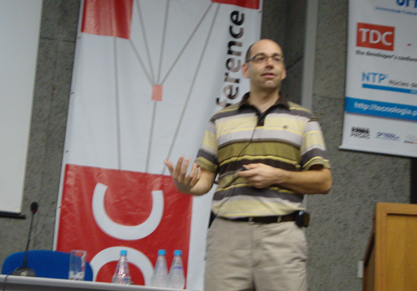Series: TDC Rio 2009 | Part 1 of 2 > Key insights from Brazil’s premier Java conference

Mike Keith’s talk started around 11 a.m., just after the coffee break. He kicked off with a light tone and a bit of humor about the long wait between Java version releases. One early slide showed a bold phrase:
“Or maybe you don’t care because Microsoft will kill Java anyway.”
The jab got a few laughs — but also set the tone for a serious point: despite criticisms, Java EE 6 was evolving, and this release brought real improvements that deserved attention.
Java EE 6: More Modular, Less XML
Mike walked through some of the major updates in the new specification. One of the most welcome changes was the reduction of XML configuration. With the introduction of annotations (@Annotation), a lot of previously external settings could now live directly in the code.
@WebServlet("/myRoute")
public class MyServlet extends HttpServlet {
// ...
}
Previously, this would have required a chunk of XML in web.xml. Now, it’s all embedded and more intuitive.
Annotations and Modularity: Ending Hidden Coupling
Annotations also helped expose which behaviors and dependencies are active in each class. This made hidden coupling — where key logic lived in invisible XML — far less likely.
This shift was also aligned with popular frameworks like Spring, JSF, and Struts, which had already embraced annotation-driven configuration.
Asynchronous Servlets (Async Processing)
A particularly exciting update was the addition of asynchronous support for Servlets. Rather than blocking a server thread while waiting for a long-running task (like a remote API call), servlets could now offload the task and continue handling new requests.
In plain terms: the server doesn’t sit idle anymore — it gets more done with fewer resources.
Mike reminded us that while powerful, async servlets introduce complexity, and developers must take care to avoid race conditions and concurrency bugs.
EJB 3.1: Time for a Comeback?
When Mike mentioned EJB, I expected some eye-rolling. But he surprised us with updates that made EJB 3.1 feel relevant again — even modern.
Highlights included:
- Lightweight EJBs that could run outside full enterprise containers
- Optional use of interfaces
- Better integration with plain Java SE environments
The room seemed genuinely curious — maybe because EJB was finally shedding its baggage.
JPA and Afternoon Discussions
While JPA (Java Persistence API) was only briefly discussed during the talk, the interest it generated was so strong that it became a side conversation later in the afternoon.
For those unfamiliar, JPA provides a standard for object-relational mapping in Java. Instead of raw SQL, we define Java classes and annotations that represent database entities.
Dependency Injection (JSR 330)
Another highlight was JSR 330, which formalized the idea of dependency injection — a technique long popularized by Spring and others.
The idea is to shift object creation to a container, reducing coupling and simplifying testing.
This marked another step toward aligning the Java EE platform with modern development practices.
An Optimistic Outlook
Mike closed with an encouraging message: many of these new features were already available in beta or public spec drafts and were expected to become official by December 2009.
The takeaway was clear: Java EE 6 wasn’t just keeping up — it was cleaning up. The platform was becoming more modular, productive, and responsive to developers’ real needs.
Posted the same day as Mike Keith’s talk at TDC Rio 2009.
Series Navigation
- Current: Part 1 - Mike Keith - Java EE 6: A Major Evolution
- Next: Part 2 - Rod Johnson on Java EE trends and the next 5 years
- Complete series: TDC Rio 2009 Series